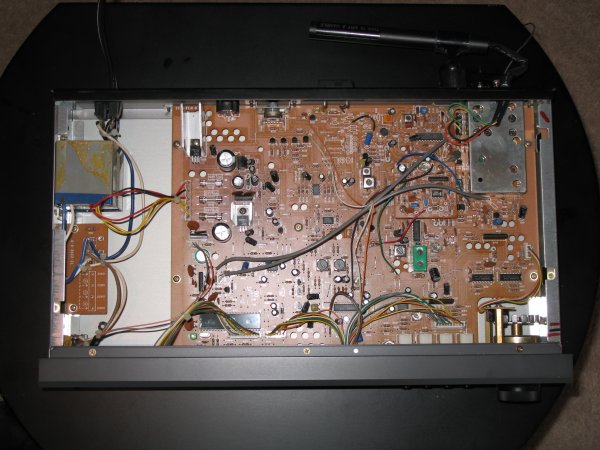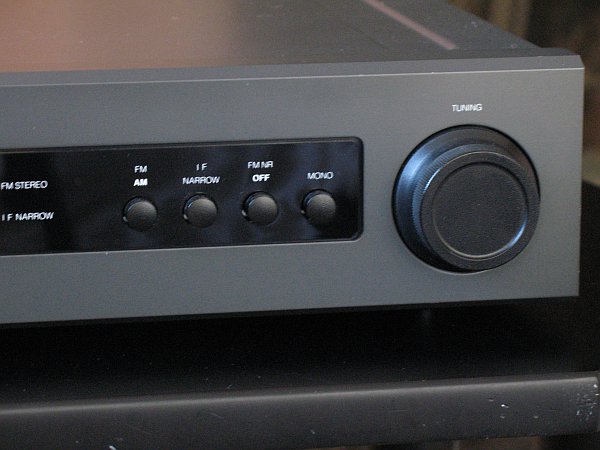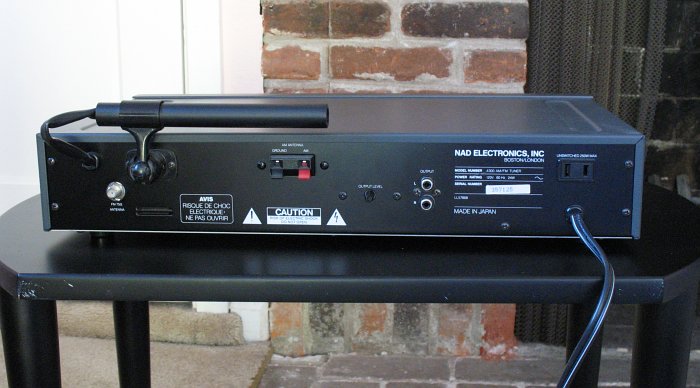
The title says "tuner" because my longtime reference for FM reception ability and sound quality has been a high-fidelity component tuner, the NAD 4300 AM/FM tuner.
The tuner was part of NAD's top-end Monitor Series line in the late 1980s and early 1990s. I purchased my first 4300 in 1989, and still have it.
Note that this is a tuner intended to be a component in a hi-fi system. You'll need at least a preamplifier for headphone listening and, to listen to speakers, an amplifier as well.

At the time, the NAD 4300 was unusual in being digitally tuned tuner with a tuning knob. Each movement of the knob tunes the unit in 50 kHz increments on FM; AM stations are tuned in 10 kHz steps. There is a small flywheel within the tuner to give the tuning knob the requisite heft that one expects from a tuner. (You can see it in the photo of the tuner's circuitry to the right. The flywheel is in the lower right corner of this view.) The display is a five-digit numeric display. A five-bar LED signal-strength display is immediately under the frequency readout.
There are eight presets each for the AM and FM band. In 1990, that would have been considered an ample number of presets. In the 2020s, radios commonly have more presets than you could ever use, with anywhere from 20 to 100 being common. The NAD 4300 is clearly from an earlier time. Still, in other ways, it could be considered a precursor to the high-performance DSP-based radios of the 2010s and beyond.
The NAD tuner's performance specifications are ambitious, especially for sensitivity and selectivity. While I've never had it measured, I believe the tuner promises what it delivers, based on my 20 years of experience with it. I bought a second 4300 on Audiogon a few years, and it has performed equally well.
I have found three sets of performance specifications for this tuner! One set is found in sales brochures; the other two are in the service manual. One of those is for US models while the other is for non-US models.
For example, mono sensitivity is specified at 9.0 dBf (brochures), 9.3 dBf (US service manual), or 9.6 dBf (non-US). Sensitivity at 50 dB quieting in stereo is specified at 34.0 dBf (brochures), 33.5 dBf (US), or 34.5 dBf (non-US). Stereo S/N ratio is specified at 80 dB (brochures), 78 dB (US), or 77 dB (non-US). I have no explanation for the difference among the three sets of specifications.
Documentation for the tuner states that it has a five-gang "tuning system" including four stages of RF filtering. There are three IF-stage filters. FM bandwidth is selectable.

There is also a blend circuit that NAD calls "FM NR" (controls shown in the photo at the left), which works by reducing the L-R component of the FM stereo signal, varying upon the signal strength of the station. Blending is never total; some separation is still retained for weak signals. The "FM NR" circuit can be switched off when desired. The feature does remove significant amounts of noise, though, on very weak signals, it is quite apparent that separation has been reduced.
The tuner's audio output is variable, with the level control on the back panel. (The back panel is shown in the photo toward the end of this review.)
This has been a tuner ideal for challenging reception environments, such as fringe areas, and locations with severe blanketing problems, such as being near multiple-high power FM transmitters. While the brochures for the tuner claim image rejection of 120 dB (110 dB in the service manual), my experience (from my time living in Kansas City) has been that additional RF filtering between the antenna and the tuner still helps tremendously in blocking out unwanted signals.
The narrow bandwidth is helpful in rejecting alternate-channel signals, at very little apparent cost to sonic quality. It's also great for DXing, both due to the performance and the ability to use a tuning knob rather than up-or-down buttons. I have noticed that the volume drops a little bit when switching from wide to narrow bandwidth, and the stereo soundstage can be affected slightly. But, even for routine reception, the compromises are more than acceptable.
That said, if sonic quality is more important to you than reception performance, this may not be the tuner for you. The tuner is clinically accurate; it won't cover up the flaws of a badly processed FM signal. But, on a clean, well-engineered station, the tuner's sonic performance is very good. It's listenable for hours at a time.
There's an important precondition: the tuner must be aligned for best results. Even a minor misalignment can result in a gritty, distorted sound, especially on aggressively modulated signals. There was a period in my life when I moved this tuner around frequently; those moves seemed to knock it out of alignment ever so slowly. There was also a small circuit board hosting the IF filters that came loose, generating additional noise within the tuner. That's been fixed. The moral of that story is to avoid moving this tuner around a lot.
The AM tuner is surprisingly sensitive, with more bandwidth and interference rejection than the typical AM tuner afterthought, but suffers from a narrow audio bandwidth. It's pleasant enough when listening to news or talk programs, but not all that pleasant for music. My vintage Zeniths sound better; my GE Superadios sound better and have better sensitivity. The DSP-based radios of the 21st century often have more controls for improving distant reception, and for improving fidelity of stronger local signals, through providing multiple choices for audio bandwidth filters. The NAD has only one AM bandwidth. The NAD's AM tuner is selective, however.
On FM, modern DSP-based radios can be just as sensitive as the NAD 4300, and, often, more selective. Even so, to my ears, the NAD 4300 just sounds better. The DSP radio that comes closest (when listening with headphones) in audio quality to the 4300, in my opinion, is the Qodosen DX-286, which apparently has a separate headphone amplifier in addition to its built-in speaker. Other radios seem to have a "flatter" sound compared to the Qodosen and, definitely, compared to the NAD 4300.
Overall, this has been an ideal FM tuner for most difficult reception locations, and an excellent one for all others, especially for receiving weak stations or a weaker station crowded between stronger ones.
Comparing performance to modern DSP radios
This review has been up for a long time. For one thing, the station tuned in the photo at the start of the review was San Francisco's KFOG(FM); it's been KNBR-FM since 2019 and no longer broadcasts in stereo. In addition, I moved to Colorado in 2023. The reception environment is different in Denver; there are more low-power translators and nonprofit stations, and I'm no longer perched atop the Oakland hills where signals are abundant. Instead, I'm in a very flat part of Denver. There are still plenty of signals available, but some low-power stations have challenges reaching me from their base on Lookout Mountain.
In a new environment, I wanted to see how the tuner compared to the second generation of DSP-based radios that came out in 2023 and 2024. Specifically, I wanted to see how the NAD 4300 stacked up against the Tecsun PL-320 and the Qodosen DX-286.
I've published the detailed evaluations of these FM radios along with a spreadsheet of the raw data behind the comparisons.

Summarizing my conclusions, I found that the three radios were similar in their sensitivity to weak signals. My scoring method tries to account for both sensitivity and selectivity. The newer DSP-based radios are a little more selective than the NAD 4300, so they scored just a little higher in my evaluation.
There's a very good test of receiver selectivity available in Denver. There's a region of the FM dial where four low-power or fringe signals are on adjacent frequencies: 93.7, 93.9, 94.1, and 94.3. This happened because the Federal Communications Commission lowered some technical standards in order to allow more translators and nonprofit low-power stations to be squeezed into the dial. Radios made before the DSP era tend to have problems keeping these four stations apart. That's true for the NAD 4300 as well, even with its narrow-bandwidth option on FM. I believe almost any radio made before the DSP era, which dates to around 2009, will have issues in similar circumstances.
The amazing thing to me is that radios costing less than $100 now have performance equal - or a little better! - to a tuner that cost four times as much (in nominal dollars, not accounting for inflation!) more than 30 years earlier.
Keeping all these factors in mind, I still have a high regard for the NAD 4300 and plan to keep enjoying it for years to come.